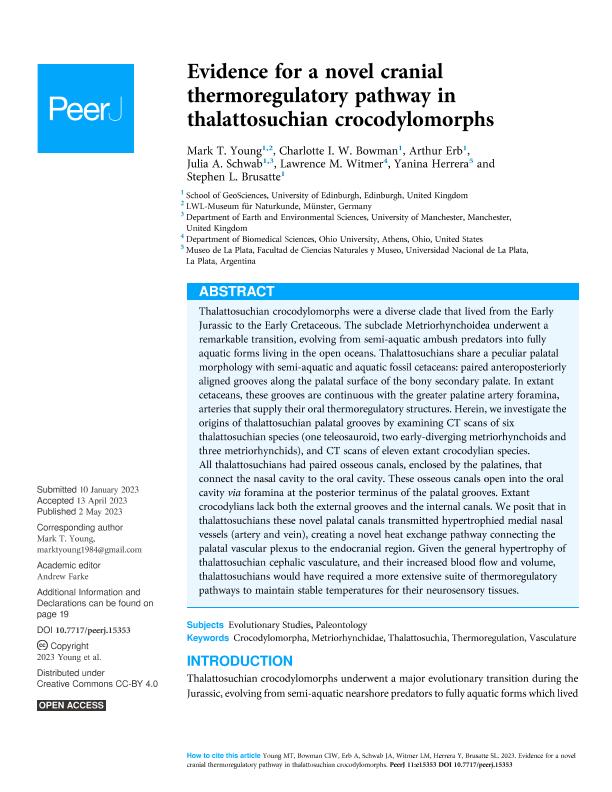Artículo
Evidence for a novel cranial thermoregulatory pathway in thalattosuchian crocodylomorphs
Young, Mark T.; Bowman, Charlotte I. W.; Erb, Arthur; Schwab, Julia A.; Witmer, Lawrence; Herrera, Laura Yanina ; Brusatte, Stephen L.
; Brusatte, Stephen L.
 ; Brusatte, Stephen L.
; Brusatte, Stephen L.
Fecha de publicación:
05/2023
Editorial:
PeerJ Inc
Revista:
PeerJ
e-ISSN:
2167-8359
Idioma:
Inglés
Tipo de recurso:
Artículo publicado
Clasificación temática:
Resumen
Thalattosuchian crocodylomorphs were a diverse clade that lived from the Early Jurassic to the Early Cretaceous. The subclade Metriorhynchoidea underwent a remarkable transition, evolving from semi-aquatic ambush predators into fully aquatic forms living in the open oceans. Thalattosuchians share a peculiar palatal morphology with semi-aquatic and aquatic fossil cetaceans: paired anteroposteriorly aligned grooves along the palatal surface of the bony secondary palate. In extant cetaceans, these grooves are continuous with the greater palatine artery foramina, arteries that supply their oral thermoregulatory structures. Herein, we investigate the origins of thalattosuchian palatal grooves by examining CT scans of six thalattosuchian species (one teleosauroid, two early-diverging metriorhynchoids and three metriorhynchids), and CT scans of eleven extant crocodylian species. All thalattosuchians had paired osseous canals, enclosed by the palatines, that connect the nasal cavity to the oral cavity. These osseous canals open into the oral cavity via foramina at the posterior terminus of the palatal grooves. Extant crocodylians lack both the external grooves and the internal canals. We posit that in thalattosuchians these novel palatal canals transmitted hypertrophied medial nasal vessels (artery and vein), creating a novel heat exchange pathway connecting the palatal vascular plexus to the endocranial region. Given the general hypertrophy of thalattosuchian cephalic vasculature, and their increased blood flow and volume, thalattosuchians would have required a more extensive suite of thermoregulatory pathways to maintain stable temperatures for their neurosensory tissues.
Palabras clave:
CROCODYLOMORPHA
,
METRIORHYNCHIDAE
,
THALATTOSUCHIA
,
THERMOREGULATION
,
VASCULATURE
Archivos asociados
Licencia
Identificadores
Colecciones
Articulos(CCT - LA PLATA)
Articulos de CTRO.CIENTIFICO TECNOL.CONICET - LA PLATA
Articulos de CTRO.CIENTIFICO TECNOL.CONICET - LA PLATA
Citación
Young, Mark T.; Bowman, Charlotte I. W.; Erb, Arthur; Schwab, Julia A.; Witmer, Lawrence; et al.; Evidence for a novel cranial thermoregulatory pathway in thalattosuchian crocodylomorphs; PeerJ Inc; PeerJ; 11; 5-2023; 1-26
Compartir
Altmétricas



